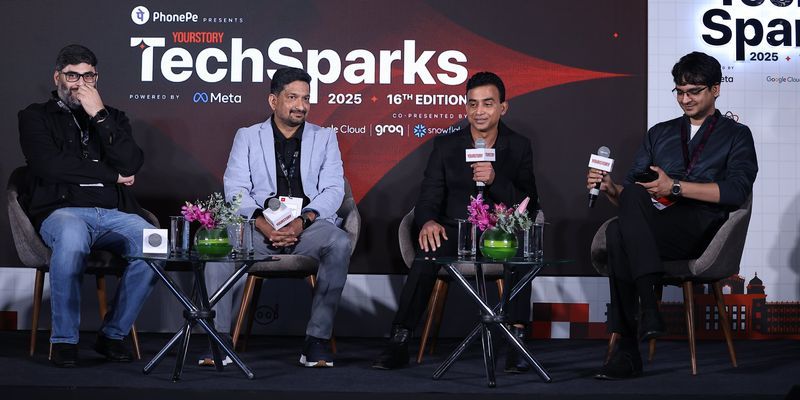Copyright yourstory

As agentic AI evolves from task executors to autonomous collaborators, it is reshaping workplace hierarchies, creativity, and accountability. From finance to HR, AI agents are quietly automating decision layers once handled by humans. At TechSparks 2025, a panel featuring Ankush Sabharwal (Founder and CEO, CoRover.ai), Jithendra Vepa (Co-founder and CTO, Observe.AI), and Manoj Agarwal (Co-founder & President, DevRev) explored how AI agents are transforming enterprise collaboration and productivity. Speaking at the session, Agarwal shared how DevRev envisions AI transforming the enterprise landscape. “If you look at ChatGPT today, it works because it’s trained on publicly available internet data. What OpenAI managed to do was structure that vast amount of data through weights and biases applied to large language models,” he said. “But in the enterprise world, data isn’t public — it’s private, governed by security, compliance, and role-based access controls. So the challenge becomes: how do you create a ChatGPT-like experience within the secure environment of an enterprise?” That question, he explained, inspired the founding of DevRev five years ago. “We wanted to build a system that lets teams not just search through enterprise data, but also reason with it, take action on it, resolve issues, and collaborate more intelligently. Essentially, we’re enabling AI-powered collaboration that’s secure, context-aware, and truly enterprise-grade.” Vepa, Co-founder and CTO of Observe.AI, reflected on his company’s journey. “We started Observe.AI about eight years ago with one goal — to transform contact centres using AI,” he said. “Contact centres are a goldmine of customer insights, but much of that data goes untapped because processes like quality checks and coaching are still manual and subjective.” Traditionally, agents were evaluated on just one or two calls every few weeks — a biased and limited sample. “So we thought, why not use AI to analyse 100% of those conversations? That way, evaluations become objective, and agents can get real-time feedback to improve,” Vepa explained. Over time, Observe.AI’s focus expanded from analytics to real-time assistance. “With advances in LLMs and retrieval-augmented generation, agents can now find accurate answers instantly instead of putting customers on hold while they search through massive documentation. Earlier chatbots were reactive — they answered questions. These new AI agents can understand intent, take action, and continuously learn. They’re not just assistants anymore; they’re collaborators.” Sabharwal described how the company evolved from chatbots to a full-stack enterprise AI platform. “Earlier, we used to tell enterprises, you need a chatbot. Today, we tell them, forget the buzzwords. Whether you call it AI, an agent, or a solution — what matters is solving real business problems.” CoRover helps enterprises build their own small language models on proprietary data. Through its Generative AI Care platform, it offers prebuilt solutions for sales, support, and workflow automation. Founded in 2016, the company now has a developer community of over 40,000 and recently set a world record when 7,000 AI agents were created on its platform in a single day, breaking Google’s previous record of 2,000. “But what really excites us is not the records or the tech — it’s how we can help enterprises achieve their purpose, even if we can move the needle by just one percent,” Sabharwal said. Measuring productivity in an agentic world How do you measure productivity when your co-workers are algorithms? “In the deterministic world of traditional automation, we knew exactly what logic was at play — ask the same question a million times, and you’d get the same answer,” said Agarwal. “But in the agentic AI world, productivity is no longer about repeatability — it’s about adaptability.” He added, “We’re moving from machines that follow rules to systems that reason. At first, AI works in assist mode, helping humans make better decisions. Over time, as trust builds, we shift to auto mode — where AI and humans collaborate side by side, each defining priorities and routing tasks. That’s where true productivity emerges.” For Vepa, the evolution of AI is not about replacement but cooperation. “I see it more as human–AI collaboration,” he said. “Most customer interactions today start with a bot that authenticates and resolves simple issues. If it can’t, it seamlessly hands over to a human agent. The ownership isn’t on one side — it’s shared.” Observe.AI uses rigorous testing to ensure reliability. “Just like human agents are trained and assessed on processes and policies, AI agents also go through synthetic conversations to test their predictability. We’ve moved from a deterministic to a probabilistic paradigm — but even here, we can clearly identify where AI performs best and where biases appear.” When asked about AI’s limits and the risks of hallucination, Sabharwal was unequivocal. “We, as a company, are not okay with AI agents hallucinating even 1% — because we operate in B2B. It’s okay for a kid or a general-purpose model like ChatGPT to hallucinate — those are for exploration. But when you’re building an agent for banking, financial literacy, or train bookings, there’s no room for error. If the AI gives a wrong answer, users lose trust.” He added, “We prefer not to answer rather than hallucinate. These agents are not for fun — they’re built for trust, accuracy, and purpose.” Interestingly, Sabharwal noted that while human handovers sound ideal in theory, most enterprise clients avoid them. “Solutions we’ve built for RBI, NPCI, IRCTC, SEBI, and LIC all operate without human handovers — and still maintain over 95% accuracy,” he said. He concluded with a deeply human example,“One student built an agent on our platform to keep his late mother’s teachings alive. It’s stories like these that remind us — AI can be deeply human when built with the right intent.” (Edited by Jyoti Narayan)



